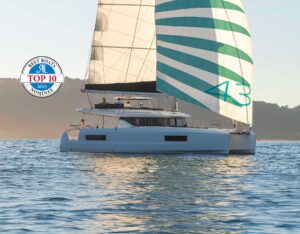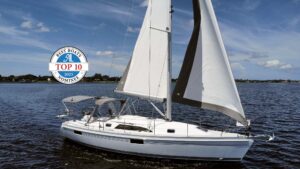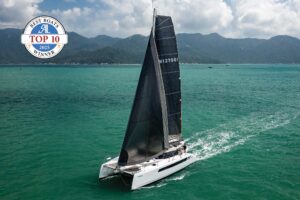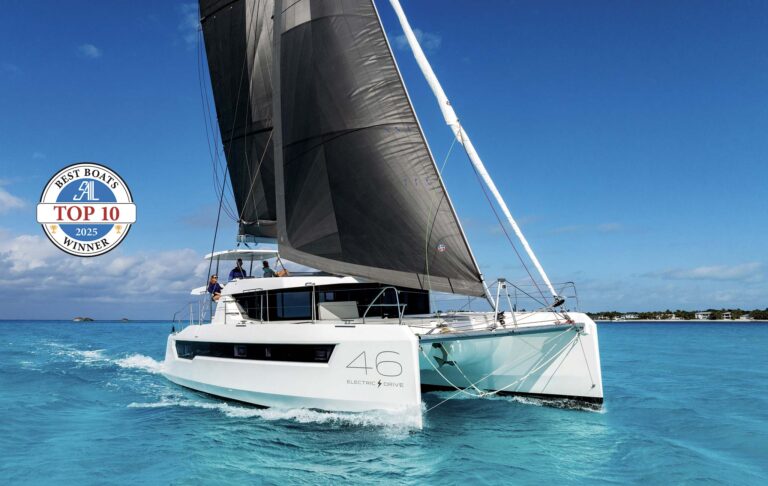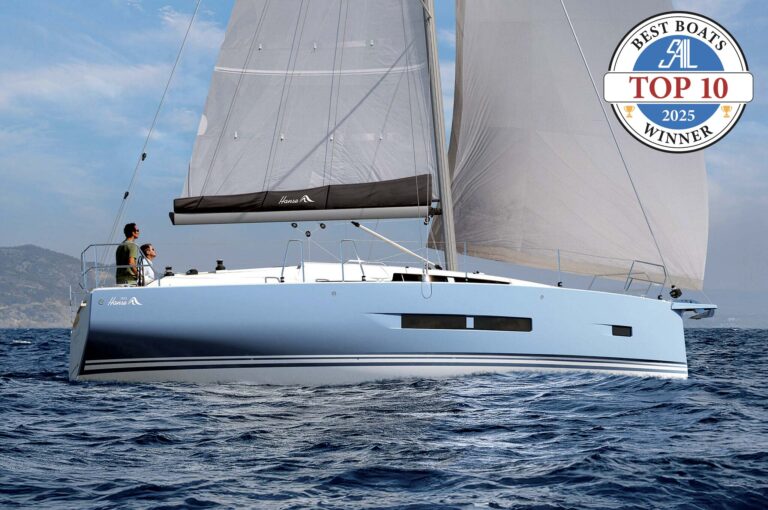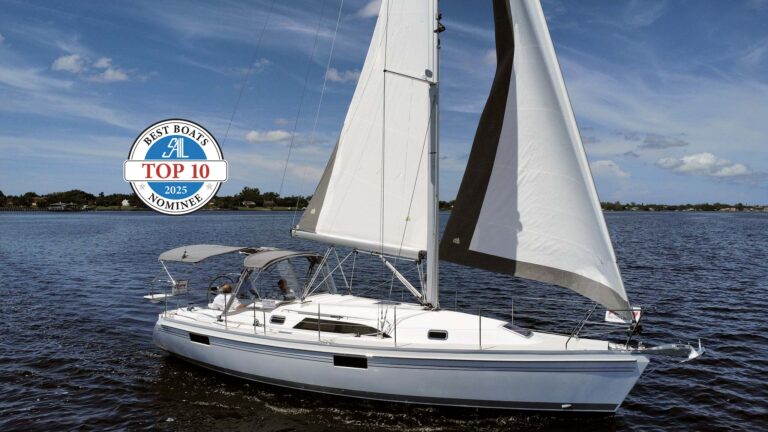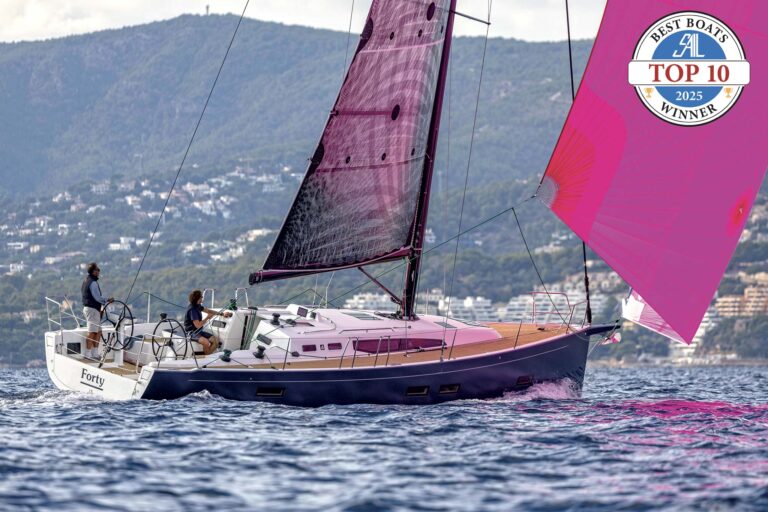
When you have a successful product, you don’t completely change its design. You tweak it. The Dufour 360 is a well-tweaked version of the Dufour 350, and the changes are quite worthwhile.
DESIGN & CONSTRUCTION
Dufour has always been a step above many standard production boats in fit and finish quality, and the 360 is no exception. The joinery is precise, the wood grains are quite attractive, and little touches like airlifts on lockers abound.
On a more basic, structural level, Dufour hulls are made of vacuum-bagged fiberglass, and the decks are laminated with a foam core. I found the plumbing throughout to be neat, bundled and labeled, and all hoses and connections to the metal seacocks double-clamped and secure. Wiring harnesses behind the panel are similarly neat, although all the positive leads are red, so a technician will need to have diagrams of the connector pinouts in order to do any troubleshooting—not a good thing. Color-coded wires for specific circuits are better.
ON DECK
It is easy to move about on deck and to step up onto the cabintop aboard the Dufour 360. The boom is also low enough for a person of normal height to reach, an important feature that buyers may overlook until it comes time try to adjust something up there. Using teak for the toerail is a nice touch, and the amount of teak is small enough that nobody will be offended if you let it turn gray with age rather than keep it varnished. The anchor lives on a short bowsprit that can also be used to secure the tack of an A-sail, a setup that will be handy for cruising.
Beyond that, the changes from the Dufour 350 to the 360 include a new deck mold that incorporates a fixed port in the front of the cabinhouse, new steering pedestals and a grill at the aft end of the cockpit. The new stern configuration might sound like a gimmick, but it’s actually a very cool idea, as the transom platform drops down to perform double duty as both a swim step and the floor of a cooking area for working at the built-in grill and countertop.

ACCOMMODATIONS
The interior is attractive, with a white plastic hull ceiling warmed up by plenty of well-finished wood and, on our test boat, gray upholstery. There’s a feeling of spaciousness, accentuated by double-door access to the forward cabin, which gives easy access to the berths there.
Long settees are located to port and starboard in the saloon, with a mast compression post amidships. There’s plenty of main-cabin stowage space for a long coastal cruise. Besides the cabinets located at shoulder height, there’s also space under the settees and behind the backrests.
To starboard, there’s a nice nav station with a table big enough for a chartbook or a laptop computer. The panel space for mounting a VHF radio, stereo and other electronics includes easy access from the rear for the wiring.
The galley to port is well equipped with a double sink and a two-burner propane stove. There are also covers for all the surfaces to yield the maximum working countertop space, although stowage space is somewhat limited.
The designer-style head has Corian surfaces, a fashionable, top-mount sink bowl, a handheld shower and an opening port for ventilation and light. Stowage space in the head is good. There’s even stowage to be had under the cockpit seat, accessible through a door in the aft end of the compartment. The second sleeping cabin is aft on the port side, and it occupies roughly the same size space as the head compartment and its underseat stowage to starboard. It’s cozy but comfortable and has reasonable headroom.
UNDER SAIL
The Chesapeake was cluttered with debris the day of our test sail due to an emergency opening of the Conowingo Dam on the Susquehanna, which sent a deluge down the bay. However, good sightlines and positive control from the helm made avoiding the flotsam easy. The warm, late summer day greeted us with around 10 knots of wind.
Equipped with the shoal-draft keel, our test boat was responsive and pleasant to sail, with just the right amount of weather helm and excellent, smooth feedback from the rudder. In that perfect breeze, I measured 5.5 knots of boatspeed to windward and a bit over 6 knots on a close reach, dropping to just below 5 knots downwind, as to be expected without a spinnaker. The lapper jib moved smoothly through the foretriangle, and the boat tacked easily through less than 90 degrees.
The rig is set up nicely for people of average strength. I was able to raise the mainsail and trim the sails by myself easily, and I am years beyond being a deck ape. The German mainsheet system worked smoothly, and I found the line loads quite manageable without power-assisted winches. The sheet leads are excellent for singlehanded sailing as they come close to the helm with stoppers and self-tailing winches. That said, I would have liked to have had better line tail stowage, especially for the main halyard.
UNDER POWER
Engine access on the Dufour 360 is under the steps, with an additional panel in the aft cabin. As with almost any boat this size, the space is small, but at least all the maintenance points are reachable.
Our test boat had the optional 30hp Volvo engine instead of the standard two-cylinder, 19hp powerplant. This three-cylinder model is undoubtedly smoother running, and its extra oomph might be reassuring when forcing through big waves.
At 2,500 rpm, the 6.3 knot cruising speed was comfortable. Revving up to 2,800 rpm pushed us along at 7 knots, slightly under the displacement hull limit for this waterline length. All the standard powering maneuvers forward and reverse were easy and precise, with a turning circle under 1 1/2 boatlengths.
CONCLUSION
The Dufour 360 is a pleasant, attractive boat with good performance. It will be a fine cruiser for a family or an older couple, with the forgiving qualities that make it manageable by a single sailor.

Specifications
LOA 33ft 8in LWL 29ft 7in
BEAM 11ft 7in
DRAFT 6ft 2in (std.); 5ft 1in (shoal)
DISPLACEMENT 12,509lb
BALLAST 3,417lb
SAIL AREA 624 ft (100% FT)
FUEL/WATER (GAL) 42/58
ENGINE 19hp Volvo
Ballast Ratio 27
SA/D Ratio 16 D/L Ratio 217
What do these ratios mean? Visit sailmagazine.com/ratios
DESIGNER Umberto Felci
BUILDER Dufour Yachts, La Rochelle, France, dufour-yachts.com
PRICE $221,000 (sailaway) at time of publication.
April 2020

